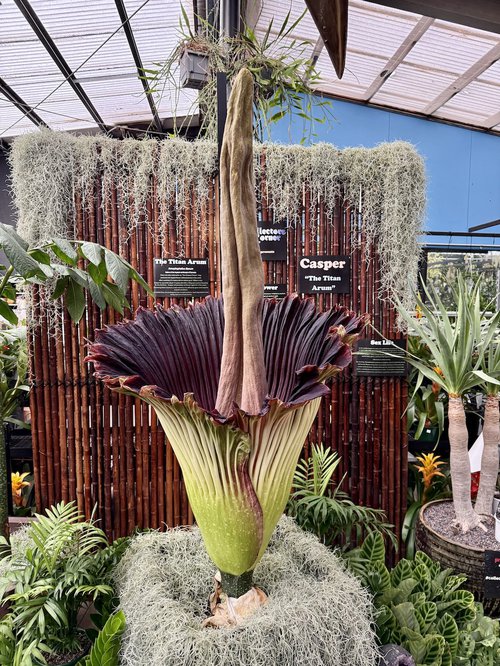Casper the Corpse Flower
Jan. 9, 2025
A Rare Bloom and the Wonders of Pollination
The Titan Arum (Amorphophallus titanum), commonly known as the corpse flower, is, we think, one of the most fascinating plants in the world. Recently, a corpse flower named Casper bloomed at Collectors Corner in GardenWorld, Braeside, offering the public a rare chance to see this botanical marvel.

Dr. Edwin Lampugnani, one of Melbourne Pollen’s contributors, had the privilege of visiting Casper during its brief bloom. “It’s an incredible plant, not just because of its size and smell, but because of how it has evolved to interact with its environment. It’s a reminder of the incredible diversity of pollination strategies in the plant world,” Dr. Lampugnani explained.
This rare bloom offers a wonderful opportunity to explore the fascinating differences between pollination systems—especially the contrast between wind-pollinated species, like grasses that cause hay fever, and the corpse flower’s insect-driven approach.
How the Corpse Flower Is Pollinated
The corpse flower is a master of deception. When it blooms, it releases a powerful smell of rotting flesh, designed to mimic decomposing organic matter. This stench attracts carrion-loving insects like flies and beetles, which act as the plant’s pollinators.
Inside the bloom, the plant produces male and female flowers at different times. First, the female flowers become receptive to pollen brought by insects from other blooms. Later, the male flowers produce their own pollen, which attaches to visiting insects, ready to be carried to another plant.
This strategy, called insect pollination, is precise and highly specialized, ensuring successful reproduction in its native rainforest environment where other plants compete for pollinators.
Wind Pollination vs. Insect Pollination
For those of us who suffer from hay fever, grass pollen is a familiar foe. Unlike the corpse flower’s targeted pollination strategy, grasses rely on wind pollination to reproduce. Here’s how they differ:
Wind-Pollinated Grasses:
Grasses, such as ryegrass, produce massive quantities of lightweight, dry pollen that is released into the air. The wind carries this pollen over vast distances, increasing the chances of it reaching another grass plant. However, this indiscriminate method is why grass pollen is one of the biggest triggers for hay fever, as it easily enters our airways.
Corpse Flower (Insect-Pollinated):
The corpse flower uses scent, heat, and timing to attract specific insects that carry its pollen. This method is much more targeted than wind pollination, minimizing waste and ensuring the pollen reaches another Titan Arum.
While grasses produce massive volumes of pollen to ensure success, the corpse flower takes a more energy-intensive but precise approach, relying on its partnership with pollinators.
Why Casper’s Bloom Matters
Casper’s bloom is a reminder of the incredible diversity in plant pollination strategies. While grass pollen may cause sneezing fits and runny noses for many of us, plants like the Titan Arum show us how evolution has shaped species to thrive in specific ecosystems.
Understanding these differences helps us appreciate why some plants, like grasses, dominate allergy seasons, while others, like the corpse flower, are rare marvels that draw attention for their unique adaptations.
A Rare Sight
The bloom of a Titan Arum lasts just 24–48 hours, making Casper’s appearance a fleeting but unforgettable event. We thank Collectors Corner for making this experience accessible to the public and for sharing Casper with plant lovers across Victoria. Early tomorrow (Friday 10th January 2025) morning, Casper should be in a full bloom and at its best. If you have never seen (or smelt) a corpse flower before we encourage you to go and see it.
Collectors Corner is located at 810 Springvale Rd, Braeside, Victoria.


